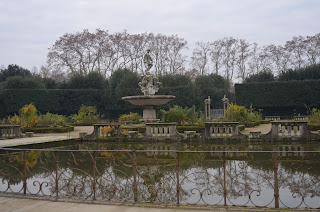We associate gardens with flowers, but it has not always been so. Before the nineteenth century, gardening was mostly about putting order in nature and interpreting that ordered nature according to classical notions of the ideal landscape. The Boboli garden is a very good example of this.
The Boboli is on a grand scale. There are kilometers of alleys between hedges. The most important ones have statues, some actually Roman.
Contrarily to the majority of formal gardens, several of the Italian ones, including the Boboli, are built on a steep bank which makes them more interesting. Below is a building called the "Kaffeehaus" (1775) with a Boboli cat (friendly).
Even if flowers play a very secondary role, there were some anemones which, dandelion-like, managed to settle and bloom on a grassy bank despite the fact that this bank is kept mowed.
I was very impressed by a hedge of oranges on a sunny wall.
The Island. At other times of the year, I believe that is the most colourful area with potted azaleas and the like.
Despite the fact the garden is in a very urban area, I was pleased to see a live heron fishing with Neptune. No doubt he is the most successful of the two.
Rather than with a marble Roman god, we end with a statue of a working gardener and his spade.
 |
| A parterre at the Boboli |
The Boboli is on a grand scale. There are kilometers of alleys between hedges. The most important ones have statues, some actually Roman.
Contrarily to the majority of formal gardens, several of the Italian ones, including the Boboli, are built on a steep bank which makes them more interesting. Below is a building called the "Kaffeehaus" (1775) with a Boboli cat (friendly).
Even if flowers play a very secondary role, there were some anemones which, dandelion-like, managed to settle and bloom on a grassy bank despite the fact that this bank is kept mowed.
I was very impressed by a hedge of oranges on a sunny wall.
 |
| Orange trees trimmed as an edge against a wall |
Despite the fact the garden is in a very urban area, I was pleased to see a live heron fishing with Neptune. No doubt he is the most successful of the two.
Rather than with a marble Roman god, we end with a statue of a working gardener and his spade.







No comments:
Post a Comment
Thank you for leaving a comment